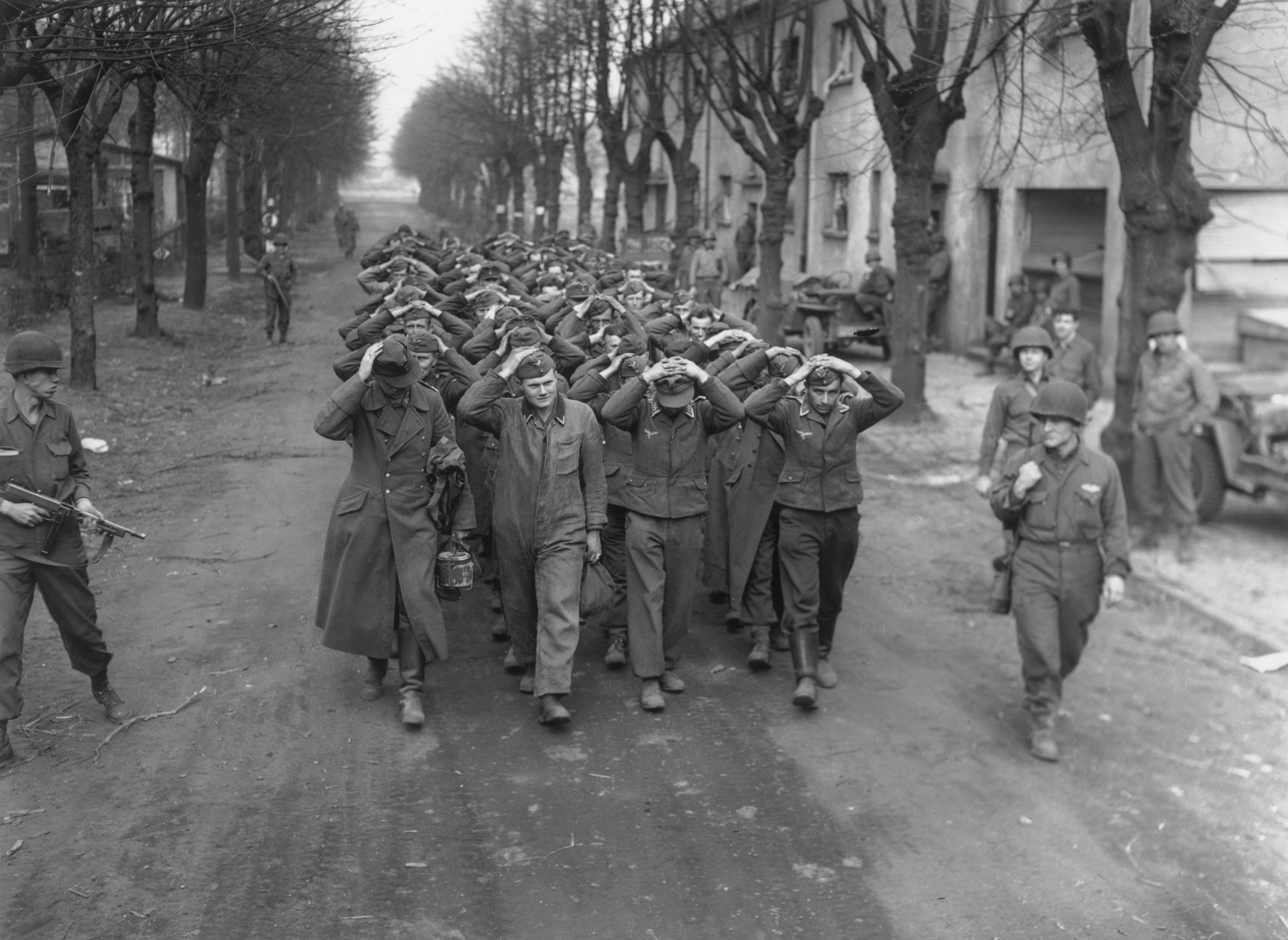The men could sense that the only thing that lay between them and the end of the war was a final push into the enemy’s heartland. The GIs of the 83rd covered 280 miles in 13 days, tightening the noose on the German troops in the Ruhr and chasing the 2nd Armored’s advancing spearheads. The 329th and its sister regiment, the 330th, raced ahead of the rest of the division, taking nearly 60,000 prisoners as Model’s Army Group B disintegrated.
By April 1, the Americans had closed the pocket completely, and began to squeeze. Tens of thousands of German troops laid down their arms as the pocket slowly collapsed. By April 18, more than 325,000 German prisoners filled the overflowing Allied POW camps.
It is this image of hordes of German prisoners surrendering to GIs—propagated by a pliant press corps for a home audience concerned about the heavy casualties during the Battle of the Bulge—that has become fixed in Americans’ minds.
The reality is that even after the mass surrenders at the Ruhr pocket, the Nazi regime, in its death throes, fought more viciously than ever. The 83rd, reaching the Elbe River at Barby, found itself entangled in house-to-house fighting with die-hard Nazis; Germany’s hastily raised civilian army, the Volkssturm, made up mainly of older men and boys; and remnants of the Wehrmacht—all supported by the occasional band of Hitler Youth. Sgt. Hobart Winebrenner of the 90th Division’s 358th Infantry related how roughly the Americans dealt with some of that resistance. When his unit moved into Mainz, “the older locals, realizing that only formalities remained, cooperated fully. But the Hitler Youth provided some of the stiffest resistance. Those aspiring young terrorists refused to quit…there was nothing quite like losing three or four friends to a kid with a rifle on a rooftop. Then the rosy-cheeked peach-fuzzed-faced freaks had the nerve to smile at us, laugh and ask for a cigarette. Let me say that some of those cocky little assassins needed extensive dental work by the time they made it back to the POW cage.”
The American response to the brutal fighting was substantially different than it had been in France, Belgium, or Holland. For the individual soldier, Germany was the cause of the war: the home of the mad dictator who had forced many of them from civilian to military life, cost them friends, and committed unimaginable atrocities. So the U.S. Army, especially at the lower levels of command, took a heavy-handed approach to the treatment of Germans, civilians and soldiers alike. If a village or town offered no resistance, its civilians would be spared the wrath of the GIs. However, the entire town would be held accountable for the acts of individual Germans.
Looting by GIs was just one type of punishment. Sgt. Oakley Honery of the 99th Infantry Division later said, “There was an unwritten code. If you had to fight for a town, anything in it was yours. If we were allowed to walk in unopposed, we treated the population much better.” Ted Hartman, a tanker in the 11th Armored Division, was involved in the fighting for the city of Regen on April 24, when “late that afternoon, a couple of the doughs [infantrymen] threw Thermite grenades and set fire to some buildings in Regen…a woman came over to one of our tanks and asked if we provided fire-fighting equipment, as her home was next door to one of the burning buildings.” The American tankers, amazed that a German civilian would expect them to put out a fire they had just started, responded by calling over one of their own who spoke German. Hartman recalled that the translator “really told her off. He took her up the street and showed her American blood and said he didn’t care if her home did burn down.”
Such destruction was magnified many times when an entire village was held accountable. Hartman wrote that if, “after ridding the berg of enemy soldiers, our men caught any fire, we’d burn the village to the ground, no questions asked.” When they entered the town of Unterbreizbach, locals fired on the advancing Americans, and the 358th burned the town down. It had the desired effect. “For the next 50 miles, frantic folks, waving white sheets and pale pillowcases, met us before we even neared their villages. They’d obviously heard about the encounter and wanted to make certain to avoid a sequel. Along this stretch, resistance wasn’t light, but rather nonexistent.”
When the 11th Armored Division’s Combat Command B entered Austria, a sniper killed the commanding officer of the lead company. Col. Wesley Yale, Combat Command B commander, ordered, “These six checkpoints [towns] ahead will be burned to the ground by nightfall. These people have got to learn that resisting is useless.” The GIs were a long way from the soft, green recruits who were drafted or volunteered in 1942. After watching American troops loot German towns that had resisted, future military historian Sgt. Forrest C. Pogue was reminded of the destruction of southern towns by the Union during the American Civil War. Southerners in the U.S. Army who were in the invading forces, he wrote, “should now understand about Sherman’s men.”





